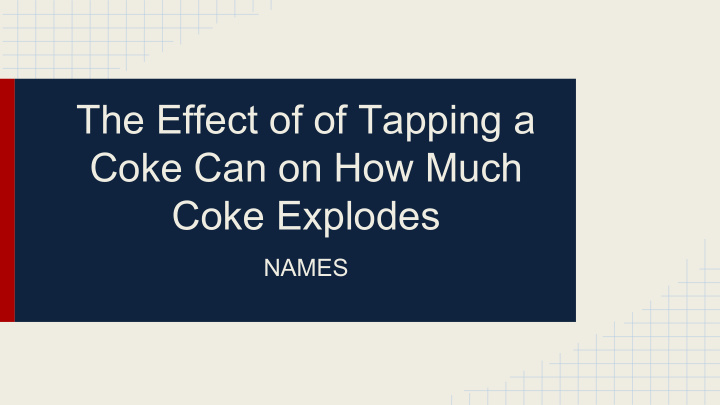



The Effect of of Tapping a Coke Can on How Much Coke Explodes NAMES
The Science Behind The Myth The bubbles in a carbonated drink like coke or sparkling water are made by pushing gas into a liquid that is under pressure. When a bottle is unopened, the liquid takes up most of the container and the gas floats in a pocket above the liquid as well as in small bubbles in the fluid. If you open the bottle without shaking it, the liquid will fizz as the carbon gas is released but it won’t spray you in the face. Shaking a closed bottle moves around the gas and liquid causing much more of the gas to go under and in the liquid in larger bubbles. Opening the bottle after shaking will cause the liquid to bubble up with the gas because the gas needs to move it up so it can be released. This is why a shaken bottle or can of coke can explode if you’re not careful.
Question + Hypothesis Which type of tapping will effect the explosion of a can of coke after it is shaken? If we are testing the effect of tapping coke on the size of explosion, then when we tap in a circle on the top of the can, it will explode the least.
Procedure 1. Shake coke five times (up, down = 1 shake) 2. Open coke without tapping (control) 3. Repeat step 2 two more times 4. Shake coke five times 5. Tap on the top of the tab five times 6. Open the coke 7. Repeat two more times 8. Shake coke five times 9. Tap around the top of the can five times 10. Open the coke 11. Shake coke five times 12. Tap on the side of the can five times 13. Open the coke 14. Repeat two more times
Variables Independent Variable: Type of tapping Dependent Variable: Amount of coke left in can after explosion (mL) Constants: type of coke, coke container, same graduated cylinder, amount of taps, type/amount of ‘shake’, amount of coke in can
Data Table Type of tapping Amount of Coca Cola left in the can (mL) Average Trial 1 Trial 2 Trial 3 No tapping 332 336 326 331.3 (Control) Tapping on tab 342 350 345 345.7 Tapping in circle 350 330 360 346.7 Tapping on sides 340 318 320 326
Graph
No Tapping file:///Users/AirMac/Downloads/One Drive-2014-09-21/WP_20140911_0 07.mp4 file:///Users/AirMac/Downloads/One Drive-2014-09-21/WP_20140911_0 02.mp4 file:///Users/AirMac/Downloads/One Drive-2014-09-21/WP_20140911_0 05.mp4 file:///Users/AirMac/Downloads/One Drive-2014-09-21/WP_20140911_0 04.mp4 Videos
Pictures
Conclusion Our myth was that if we shake a can of coke, tap the top, then open it, the soda will not explode. We decided to test different ways of tapping the Coke; five times on the tab, around the top, and on the side. When we tested the effect of tapping coke on the size of explosion, then when we tap in a circle on the top of the can, it exploded the least. Our hypothesis was correct. The can of coke that we shook then taped in a circle had an average of 346.7 left in the can after shaking, tapping, and being opened. That means that only 9.3 mL that exploded out of the can. Where as our constant had 23.7 mL explode. That is a 14.4 mL difference. To improve this experiment we could be more careful pouring the coke from the can to the graduated cylinder because it occasionally fizzled over the edge. Also to go farther we could try shaking and tapping different amounts to see what is the best combination.
Recommend
More recommend